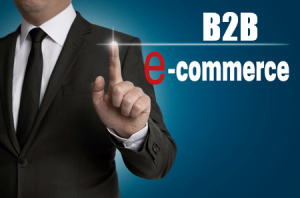
How To Start an E-Commerce Business: a Complete Guide
How To Start an E‑Commerce Business—a Complete Guide
There’s a lot to do when you’re first figuring out how to start an e‑commerce business. It can seem overwhelming to take that first step, but it doesn’t have to be.
Ready to launch your online business? Now you can sell your products or offer appointments directly from your site with Mailchimp’s commerce solutions. Plus, our built-in marketing features help you drive sales and grow your business.
The tools you need to start an online business are more accessible than ever—and so are the people who could purchase your product. Data shows that, by 2023, e-commerce revenue is expected to reach $740 billion in the U.S. alone. That’s some serious potential to start your e-commerce business and to carve out its own niche in the marketplace.
But with that potential comes plenty of challenges. There’s a lot to do when you’re first figuring out how to start an e-commerce business. It can seem overwhelming to take that first step, but it doesn’t have to be.
Start by working out the basics of your e-commerce business plan, like what you’ll be selling online and how to sell it. Map out how you want to approach the world of e-commerce and identify the things that will help you succeed. With a strong plan of action and some powerful tools at your disposal, you can build your brand and start your e-commerce business in no time.
1. Choose your niche
To start a successful online business, you have to find the right niche. What’s your area of expertise? What marketable knowledge or skill do you possess? Where do those skills fit in the market? What type of products do you want to sell?
You should have a sense of what kind of business you’ll be running, so start by researching the market. Look at other businesses in your sector and see what they’re doing right or wrong. When looking at an example of a particularly successful e-commerce business in your industry, ask yourself:
- How are they reaching customers?
- What appeals to you about their website?
- What’s their business model?
Some logistical questions you’ll need to answer when finding your niche include:
- Is your product physical or digital? Determine what type of products you want to sell.
- If it’s a digital product, how are you going to source it?
- Can you handle production yourself, or will you need help?
- Will you base your business around one-time orders, bundles, or a subscription model?
Get as many business ideas as you can, because the e-commerce market has experienced such rapid growth, you’ll be facing a lot of competition. You’ll want to do some serious thinking about what sets you and your business apart before starting your e-commerce business from scratch.
If you have expertise that’s in high demand, capitalize on that. If you have years of experience in freelance writing, for example, start a blog to write about that skill and establish yourself as a thought leader in the industry. You can use your e-commerce store to offer editing services, print on demand or paid online courses in your area of expertise.
2. Do your research
Find the top competitors in your space and do some research on their history and business model, and get products ideas by researching trending products. Ask yourself what they’re doing that you can emulate. Find out what people are looking for in your industry or niche and figure out how you can provide it in your own special way.
You’ll also need to identify the barriers to entry in your field and how you can overcome them. Will you need to invest in ads? Will you need an e-commerce software? Pay for expensive photography equipment or design software? If the answer is yes and you don’t necessarily have the money for it, what are the workarounds? What can you do with what you’ve got? It’s okay to start small and simple when setting up an e-commerce business.
Identify any gaps in the market you think your product or service can fill. Even if you’re providing something that already exists, don’t be discouraged. Just try to provide that thing in a way that nobody else can.
Once you’ve identified your place in the market and what value you’ll bring to the customer, consider conducting a SWOT analysis — which stands for Strengths, Weaknesses, Opportunities, and Threats. This can help you identify potential obstacles and plan for the future of your e-commerce business.
Strengths and weaknesses are typically things you can control, like:
- Company culture
- Your reputation
- Your customer base
- Geography
- Partnerships
- Intellectual property
- Assets
Opportunities and threats, on the other hand, are things you can’t control completely but that you can plan for, like:
- Regulation
- What suppliers are in your market
- Your competitors
- The economy
- Market size
- Market trends
- Gaps in financing
3. Choose your product and target market
There are several tried-and-true strategies you can use to choose your first profitable e-commerce product. You could solve a common pain point in the marketplace, appeal to a small niche market like hobbyists, or lean into your own personal passion. Use these strategies for finding the perfect product or service to sell.
Brainstorming your products to sell
When coming up with your product, think about your personal experience. Have you worked in a certain industry that gives you insight others don’t have?
If you’re good at spotting trends, let that inform your decision as well. Is there an opening in the market for something that people will need soon based on trends in your industry? Recognizing a relevant trend can make you a leader in the market early on.
It’s important to note that trends and fads are two different things. A fad is something that experiences a momentary surge in popularity due to its novelty. Building your business around a fad will almost certainly mean demand fizzles out once the hype dies down.
A trend, on the other hand, is something that fulfills an existing need in a new way. Because they fulfill an existing need, they aren’t something people are likely to get bored with quickly. Fads can present a good marketing opportunity, but trends have more staying power.
You can spot trends by:
- Social listening. Hang out on parts of social media where others in your industry post or where your target customers spend time, and see what they say. Browsing trending hashtags or using social listening tools to gather data over time can also provide valuable insights.
- Following search trends. Google Trends is a great place to see what trending products people are searching for. It can also tell you the keywords used most commonly in search, and what problems people are commonly trying to solve.
- Browsing e-commerce websites and aggregator sites. Pages like Trend Hunter or assorted subreddits for your niche can clue you into developing trends before they get big.
Customer reviews also provide a wealth of data on what your prospective buyers expect from a product. Browse reviews of products similar to the one you have in mind and see what people say is lacking. It is a great resource to get new products ideas. If you can, incorporate that into your product or service. Addressing an unmet need is a good way to differentiate your product in a crowded market.
When researching keywords, make sure you look outside of Google. While Google is the search engine most people use, online marketplaces like Amazon and eBay have their own search functions too.
If you’re thinking about selling a product, type in the product name on these sites and see what keywords come up. Say you’re selling kitchen knives. Typing that into Amazon’s search bar turns up suggested search terms like “kitchen knives sets” and “kitchen knives with block self-sharpening.” Those results give you an idea of what people are looking for in that product.
Finding your target market
As you’re gathering product information, study your target market. Who is your ideal customer? What characteristics do they have? This is where creating customer personas is useful.
Personas are fictionalized versions of your ideal customers that allow you to try and predict how they’ll behave. You can create a picture of the person you think would be best served by your product or service, then figure out how to appeal to that person.
Ask questions like:
- How old is this person?
- Where do they live?
- How much money do they make?
- What causes matter to them?
From there, you can infer where they’re likely to be online and what messages they’re likely to respond to. That information will help you market your product effectively when it’s time to launch your e-commerce store.
4. Validate your product
Now that you’ve developed an idea for your product and you know who you want to sell it to, you need to figure out whether you can actually execute your idea. In other words, you need to see whether your business will be viable.
You can use several criteria to evaluate your product’s viability. Evaluation criteria can be split into two main categories: market-based and product-based criteria.
Market-based criteria
These are market factors that will influence your product and business model. You’ll want to look at:
- Market size and demand for your product/service
- Who your competitors are
- Is this a trend, fad, growing market, or flat market
- Whether customers will be able to get this product/service locally
- Who your target customers are
Product-based criteria
Once you have an idea of where the market is going and who you’re marketing to, you can move on to the next set of criteria. Examine:
- Your potential selling price
- The potential markup for your product or service
- How many types or styles of product you’ll stock
- Whether you’ll offer a subscription
- The size, weight, and durability of your product, if you’re selling something physical
- Whether you’re likely to experience seasonal buying fluctuations
- Whether your product or service solves a pain point or serves a passion
- Whether your product is consumable, disposable, or perishable
- Any regulations or restrictions around your product
Analyzing your results
Looking at the market and product-based criteria can give you an idea of how much it’ll cost you to get your online business up and running. For example, if you’re selling a physical product and the price point is low, you’ll need to sell more of them to turn a profit than something with a higher premium.
Digital products, however, are cheaper to create and can be priced more according to the value they provide. That could make them a better option for a small business owner or a solo entrepreneur just starting out.
These criteria can give you a good idea of your product or service’s potential, and help you avoid common mistakes people in your niche market. If, after examining all these factors, you’ve determined that there’s enough of a market for your product, you can move on to securing other aspects of your business before launching and growing your retail business.
5. Decide how you’ll get your product
If you’re selling a physical product, you’ll need to figure out a model for obtaining it and shipping orders to your customers. There are a few models you can explore here:
Make it
You make the product yourself, by hand, and get it to the customer. This is a highly favorable option if your product is something you can get the ingredients for and make cheaply, like homemade soap or pottery. You’d need to purchase ingredients in smaller batches to start out and your profit margin would be smaller. But you can also control the cost and the risk, then scale up when you have more resources.
Manufacture it
If your product is something you don’t have the expertise or tools to make yourself, you could partner with a manufacturer. This option only makes sense if you have a product you plan to sell in large numbers, as manufacturers usually require you to order in bulk. You’ll need to be able to cover the cost of those large orders if you take this route.
Purchase wholesale and resell
This option will mean buying commercial or independent versions of your desired product and selling them through your store at a markup. You don’t have much control over pricing here, as the manufacturer sets the price of purchase and the market sets the markup. Margins for selling wholesale products are around 50%, so if you bought a product for $8 per unit, you’d typically sell it for $16.
Dropship it
A good option if you don’t want to deal with carrying inventory yourself, dropshipping involves partnering with another company that would ship your product for you after someone orders it. Since there’s no startup cost to make the product on your end, your margin is only about 20%. You’d list it on your site, and your dropshipping partner would fulfill the order.
Offer it digitally
Blog posts, templates, online video classes, tips and resources—anything people can download has the potential to be a product. Digital products can also be a service like writing, therapy, or design.
Digital downloads or services are convenient for customers and, depending on what you’re selling, they usually have a low overhead cost too. That means that offering products digitally is a good option if you’re just starting out. Don’t be afraid to experiment with different things until you hit on the product that’s right for your business.
6. Write your business plan
You’ll need a road map to follow to keep your business on track. Once you’ve decided on all the basics, writing a business plan will help you establish goals and get into the particulars of what you’ll actually need to run your business and reach your customers.
If you’re going to try and get a business loan, lenders and investors will require you to have a business plan. Make sure you make your plan as thorough and professional as possible.
Your business plan should include:
- What your business is
- What you’re selling
- How your business will earn money
- A list of employees and executive staff
- Where you’re getting financing
- Your operations model
Keep your intended audience in mind as you develop your plan. If it’s investors, make sure they can see you know what you’re doing. If it’s people you’re going to hire to work at your business, make sure they can see what your values are and how they’ll be treated.
The outline for your business plan will look something like this, from beginning to end:
- Executive summary
- Company overview
- Market analysis
- Products and services
- Marketing plan
- Logistics and operations plan
- Financial plan
If you’d like something more detailed to start with, it’s easy to find free business plan templates online.
The most important thing is to know what your goal is when you write your plan. It’ll look different if you’re writing one to secure startup funds than if you’re just outlining the business for yourself.
Make sure you keep your tone consistent throughout the document. The best way to ensure this is to have one person write the whole thing, or make sure that you have the time to thoroughly edit the document before submitting it to anyone outside your business.
Lastly, keep your business plan short and to the point. It should be 15 to 20 pages maximum. You want to make sure it’s long enough to convey the relevant information without wasting anyone’s time.
7. Pick your business name and legal structure
Naming your store is one of the more challenging aspects of starting an e-commerce business. You’ll need to come up with something that catches the eye, describes your brand, and hasn’t already been taken by somebody else.
You can typically search for business name availability on your Secretary of State’s website. It’s also a good idea to run a search with the U.S. Patent and Trademark Office.
A good business name will immediately establish a tone for your store. Take Death Wish Coffee, for example. Right away, the name tells you that this store is for people who want the strongest coffee you can buy. The name plays into the company’s hardcore, skull-and-bones branding, and the product itself is geared toward the kind of consumer drawn to that aesthetic.
When it comes to making your business name, remember to:
- Keep it simple
- Differentiate yourself
- Get creative
- Be original
Use a business name generator to help you with ideas to come up with catchy names. Once you’ve come up with your name and made sure nobody else is using it, you’ll want to register it as an online domain. You’ll use your domain name to build your online store and brand, making it easy for people to find you online.
You’ll also use your business name when you register your business. How you choose to register will affect you legally and financially down the road, so it’s worth doing a little homework to determine which type of legal structure is right for you.
You’ll register your business as one of the following:
- Sole proprietorship
- General partnership
- LLC
- Corporation
Each one will have benefits and drawbacks. If you can, consult an attorney or other legal expert to determine which one you should choose.
If you’re a business of one, you’ll likely want to register as a sole proprietor. If you go that route, you won’t legally be required to register your business in your state. Your business will just be associated with your legal name.
This also holds true for general partnerships, but you will need to file a “doing business as” or DBA application with the local government.
8. Apply for your EIN, permits, and licenses
While not all business types need an employee identification number (EIN), it can still be useful to get one because it can help keep personal and business finances separate. It’s free to apply through the IRS, and the number is usually assigned right away. You can also apply for an EIN by mail or fax.
You’ll also want to apply for any permits or licenses your business will need to operate in your state. If you’re operating your e-commerce business entirely from home, you won’t need the same kind of permits as a brick and mortar store.
That said, you will want to make sure you’ve got your bases covered. Check your local government’s website to see what business permits or licenses you might need to operate in your state.
Types of permits or licenses you might need for your business include:
- Professional and trade licenses for certain industries
- Sales tax permits
- Health, safety, and environmental permits
- Signage permits
If you do need permits or licenses, be aware that you’ll probably have to pay a fee for them. Add those expenses into your business budget up front so you don’t have to deal with any financial surprises down the line.
9. Create your online store
Now that you’re ready to launch, it’s time to choose a platform and build your online store. There are many e-commerce platforms out there to choose from, so you’ll want to see which fits your needs best.
Mailchimp stores empower entrepreneurs who want to have full control over their online business by giving them everything they need to effectively market and sell products—all in one place. From unlimited products and order management to confirmation emails and sales reports, Mailchimp has all the features needed to launch your store.
Built-in marketing tools like Creative Assistant, and marketing automation, powered by our Customer Journey builder, can help you deliver personalized messages that drive sales.
Once your customers make a purchase, keep them engaged using our email marketing tools. You can create a remarketing campaign and target folks who visit your site, send a friendly welcome email to new customers, or recommend other products your customers might be interested in.
10. Market your new business
Once everything is planned out and set up, it’s finally time to tell the world about your new business and start selling your products. Your research into your target audience should give you an idea of where you’ll run your ads and what content you’ll create now that you’re ready to bring in customers.
Don’t be afraid to use multiple channels to market to your customer base. If you’ve got a blog, promote it on multiple social media outlets. Put out content relevant to your niche on Twitter, Instagram, or YouTube. Try out different tactics in your marketing strategy, like Instagram marketing or partner up with affiliate marketers. Use shoppable landing pages that make it easy for people to buy your products.
You’ll also want to build your online store page with the intention of bringing in new leads. Be thoughtful about your page copy, product description and make sure it adheres to current SEO standards. Make sure your site is simple and easy to navigate.
If you can, invest in a customer relationship management (CRM) platform to handle your marketing efforts. This marketing tool can gather detailed information on your customer’s demographics, preferences, and behaviors to help you get the right messages to the right people at the right time and increase the conversion rates.
Set up an email list so you can have a base of people you know are interested in your product. You’ll have a direct line of communication to send them future offers, discounts, and promotions. Plus, it’s a great way for them to send you feedback on your product or service after they buy.
Get started with Mailchimp
A lot goes into starting an online retail businesse. The process can seem intimidating, but you can make it happen! Work through it step by step, and don’t worry about making things perfect right out of the gate. Learn by doing, and adapt as you go. With a little time and practice, you’ll have a successful e-commerce business you can be proud of.
Share This Article










